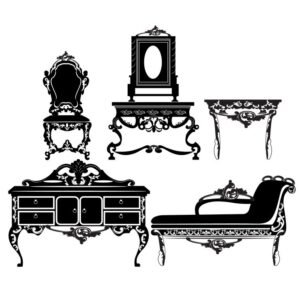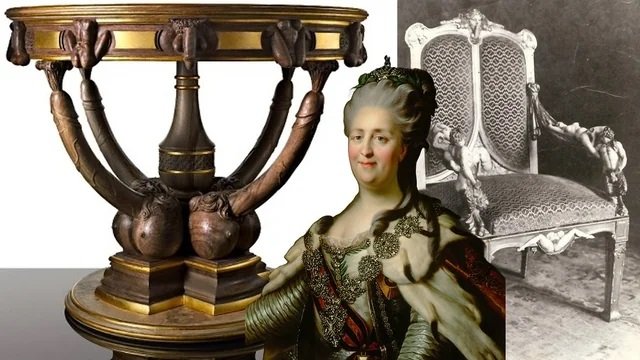Catherine the Great Furniture, Empress of Russia from 1762 to 1796, was a powerful ruler and a patron of the arts who left an indelible mark on Russian culture and European history. Her influence extended far beyond politics and military conquests; it permeated the very fabric of Russian society, including the design and craftsmanship of furniture. Catherine the Great’s furniture collection is a testament to her sophisticated taste, grandiose vision, and desire to project the might of her empire. This article delves into the opulent world of Catherine the Great furniture, exploring its origins, stylistic elements, and lasting impact.
The Origins of Catherine the Great’s Furniture
Catherine the Great’s reign was marked by a profound transformation in Russian culture and art. Influenced by the Enlightenment and her passion for Western European styles, she commissioned a wide array of furniture pieces that embodied the elegance and sophistication of the time. The Empress was particularly inspired by the French Rococo and Neoclassical styles, which were characterized by intricate designs, ornate decorations, and an emphasis on symmetry and proportion.
The furniture commissioned by Catherine the Great was not only intended to furnish the imperial palaces but also to symbolize the power and refinement of the Russian court. Her collection included pieces crafted by renowned European artisans, as well as local Russian craftsmen who were trained to meet the high standards set by the Empress. These pieces were often made from the finest materials, including mahogany, ebony, and gilded bronze, and featured luxurious upholstery such as silk, velvet, and damask.
Key Features of Catherine the Great Furniture
1. Exquisite Craftsmanship
One of the defining features of Catherine the Great’s furniture is the exceptional craftsmanship that went into each piece. The Empress demanded the highest quality and attention to detail, resulting in furniture that was both beautiful and durable. The use of fine woods, intricate marquetry, and gilded accents were hallmarks of her collection. Artisans employed advanced techniques such as veneering and carving to create intricate patterns and motifs, often inspired by classical themes, nature, and mythology.
2. Influence of French Rococo and Neoclassicism
Catherine the Great was deeply influenced by the French Rococo and Neoclassical styles, which were popular in Europe during her reign. The Rococo style, known for its playful and asymmetrical designs, was characterized by curved lines, light colors, and delicate ornamentation. Neoclassicism, on the other hand, was inspired by the art and architecture of ancient Greece and Rome and featured more restrained and symmetrical designs with an emphasis on clarity and order.
In Catherine’s furniture, these two styles were often blended to create a unique aesthetic that combined the whimsical elegance of Rococo with the grandeur and formality of Neoclassicism. Furniture pieces from this period often featured motifs such as laurel wreaths, garlands, and classical columns, as well as more fanciful elements like cherubs, scrolls, and shells.
3. Luxurious Materials and Finishes
The use of luxurious materials was another hallmark of Catherine the Great’s furniture. The Empress spared no expense in acquiring the finest materials for her collection, including exotic woods, gilded bronze, and precious stones. Mahogany, a richly colored and durable wood, was particularly favored for its beauty and workability. Ebony and rosewood were also commonly used, often inlaid with mother-of-pearl, ivory, or tortoiseshell to create intricate designs.
The finishes on Catherine’s furniture were equally lavish, with many pieces featuring gold leaf, silver plating, or lacquered surfaces. Upholstery fabrics were chosen for their sumptuous textures and vibrant colors, with silk, velvet, and brocade being the most popular choices. These materials not only enhanced the visual appeal of the furniture but also underscored the wealth and status of the Russian court.
4. Symbolism and Themes
Catherine the Great was a ruler who understood the power of symbolism, and this was reflected in the furniture she commissioned. Many pieces were adorned with symbols of imperial authority, such as the double-headed eagle, the crown, and the scepter. These motifs were often combined with classical themes, such as scenes from Greek and Roman mythology, to convey a sense of timelessness and grandeur.
Nature was another common theme in Catherine’s furniture, with many pieces featuring floral patterns, vine leaves, and animal figures. These motifs were often rendered in exquisite detail, showcasing the skill of the artisans and the Empress’s appreciation for the natural world.
The Impact of Catherine the Great Furniture on Russian Art and Design
Catherine the Great’s passion for art and design had a lasting impact on Russian culture. Her furniture collection set new standards for craftsmanship and luxury, inspiring generations of artisans and designers. The blend of European styles with traditional Russian elements that characterized her collection became a hallmark of Russian Imperial design, influencing everything from architecture to decorative arts.
The legacy of Catherine the Great’s furniture can still be seen today in Russia’s grand palaces and museums, where many of her original pieces are preserved and displayed. These works of art continue to captivate visitors with their beauty and craftsmanship, offering a glimpse into the opulent world of the Russian court.

Conclusion: A Testament to Imperial Splendor
Catherine the Great’s furniture collection is more than just a series of decorative objects; it is a testament to her reign’s artistic and cultural achievements. Each piece reflects the Empress’s vision, taste, and desire to project the power and sophistication of her empire. Through her patronage of the arts, Catherine the Great not only enriched the cultural landscape of Russia but also left behind a legacy that continues to inspire and awe.
FAQs: Catherine the Great Furniture
1. Who was Catherine the Great?
Answer: Catherine the Great, also known as Catherine II, was the Empress of Russia from 1762 until 1796. She is known for her extensive reforms in the Russian government, her support of the arts and education, and her efforts to modernize Russia along Western European lines.
2. What is Catherine the Great furniture?
Answer: Catherine the Great furniture refers to pieces that were either owned by or created during the reign of Catherine the Great. This furniture is characterized by its opulence, intricate design, and the use of high-quality materials. It often reflects the tastes and styles of the period, including elements of Rococo, Neoclassicism, and Russian Baroque.
3. What are the distinguishing features of Catherine the Great furniture?
Answer: Distinguishing features of Catherine the Great furniture include:
- Luxurious Materials: Use of fine wood, gilded elements, and sumptuous fabrics.
- Intricate Details: Elaborate carvings, inlays, and decorations.
- Classical Influence: Neoclassical design elements such as columns, pediments, and classical motifs.
- Grand Scale: Large, imposing pieces that reflect the grandeur of the Russian court.
4. Where can I see the original Catherine the Great furniture?
Answer: Original Catherine the Great furniture can be seen in several museums and palaces, including:
- The Hermitage Museum in St. Petersburg, Russia.
- The Catherine Palace in Tsarskoye Selo (Pushkin), Russia.
- Various other historical museums and collections that house Russian imperial artifacts.
5. How can I identify authentic Catherine the Great furniture?
Answer: Identifying authentic Catherine the Great furniture involves:
- Provenance: Documentation or history that traces the piece back to the era of Catherine the Great.
- Craftsmanship: High-quality craftsmanship with detailed carvings, inlays, and gilt work.
- Materials: Use of luxurious materials typical of the 18th century.
- Stylistic Consistency: Alignment with the Rococo, Neoclassical, and Russian Baroque styles of the period.
Related Post: The Grand Designs of Catherine the Great’s Furniture Legacy
